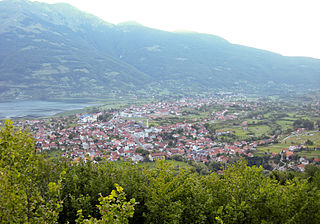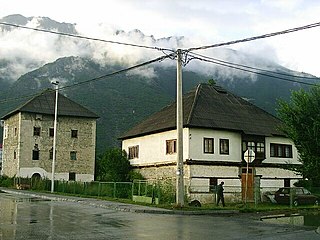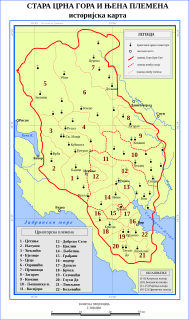The demographic history of Montenegro can be shown through census results and official documents which mention demographic composition.

Ulcinj is a town on the southern coast of Montenegro and the capital of Ulcinj Municipality. It has an urban population of 10,707 (2011), the majority being Albanians.

Medun is a settlement located 13 km northeast of the capital Podgorica, Montenegro. The village houses the archaeological site of the ancient fortified city of Medeon. It is situated in the tribal area of Upper Kuči, one of the highland tribes. In the 2003 census, it had 108 inhabitants.

Plav is a town in north-eastern Montenegro. It has a population of 3,717. Plav is the centre of Plav Municipality.

Gusinje is a small town in north-eastern Montenegro. According to the 2011 census, the town has a population of 1,673 and is the administrative center of Gusinje Municipality.
Albanians in Montenegro are an ethnic group in Montenegro of Albanian descent, which constitute 4.91% of Montenegro's total population. They are the largest non-Slavic ethnic group in Montenegro.
Piperi is a historical tribe (pleme) and region in northeastern Montenegro. Piperi is located between the Morača and Zeta rivers up to the northern suburbs of the Montenegrin capital Podgorica.

Kuči is a historical tribe (pleme) and region in central and eastern Montenegro, north-east of Podgorica, extending along the border with Albania. Its historical center is the village of Ubli.
Mrkojevići is a historical tribal region in southwestern Montenegro, located between the towns of Bar and Ulcinj. The region borders Krajina to the east. The Mrkojevići form a distinct ethno-geographical group with their own dialect of the Serbo-Croatian language. Their customs are distinct from their neighbouring Slavic and Albanian communities, but they also show influence and contacts with them. In the 400-year Ottoman period, the Mrkojevići converted to Islam, which forms an important aspect of their cultural identity.

Crmnica is a historical region in southern Montenegro, one of the communes of the municipality of Bar. It is one of the four sub-regions of Old Montenegro.

Hoti is a historical Albanian tribe (fis) and sub-region of Malësia, a divided area located in northern Albania and southern Montenegro. Its geography is mostly mountainous, but some of its villages are on flat terrain near the banks of Lake of Shkodër.

Gruda is a Northern Albanian tribe and historical tribal region in southeastern Montenegro, just north of Lake Skadar, which includes the small town of Tuzi, in Podgorica. It is inhabited by a majority of ethnic Albanians.

Shkreli is a historical Albanian tribe and region in the Malësia Madhe region of Northern Albania and is majority Catholic. With the expansion of the Ottoman Empire, part of the tribe migrated to Rugova in Western Kosovo beginning around 1700, after which they continued to migrate into the Lower Pešter and Sandžak regions. The Shkreli tribe that migrated to Kosovo converted to Islam in the 18th century and maintained the Albanian language as their mother tongue; the Shkreli in Pešter and Sandžak over time were Islamized and became Slavophone by the 20th century, so today they self-identify as part of the Bosniak ethnicity, although in the Pešter plateau they partly utilized the Albanian language until the middle of the 20th century. The Shkreli in Albania and Montenegro are predominantly Catholic. The Shkreli tribe's patron saint is St. Nicholas (Shënkoll).

Šas is a village in Montenegro. According to the 2003 census, the village had a population of 268 people. It is located east of Ulcinj.

Ambula is a village in the municipality of Ulcinj, southeastern Montenegro, located near the Albanian border.

Darza is a village in the municipality of Ulcinj, southeastern Montenegro. It is a multi-ethnic settlement, inhabited by Montenegrins, Serbs and Albanians.

Vladimir is a village in the municipality of Ulcinj, Montenegro.

Brajše is a village in the municipality of Ulcinj, Montenegro. It is located north-east of Ulcinj town.

Kryethi was an Albanian tribe (bashkësi) of the Middle Ages in the coastal areas of northern Albania and southern Montenegro.

Krute Ulcinjske, or just Kruta, is a village in the municipality of Ulcinj, Montenegro.








